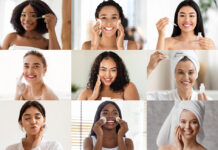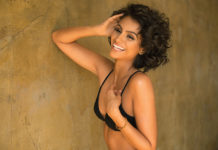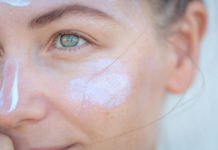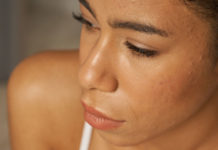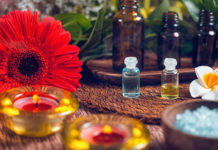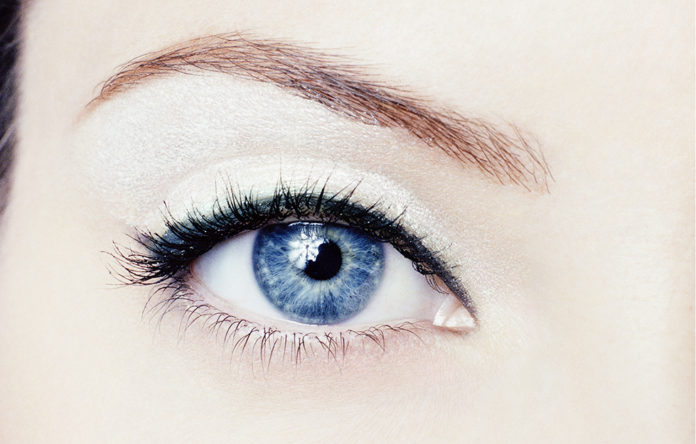
HERE’S WHY YOU HAVE DARK UNDER-EYE CIRCLES AND
HOW TO GET RID OF THEM – OR HIDE THEM PERFECTLY
BY COLETTE CORMIER | PHOTO BY KIMBERLY METZ
Under eye circles may well be one of the greatest beauty struggles of all time. Before you put finger to face and try to cover them up, take a few minutes to ponder what’s at the root of your circles. Chances are you can lighten them up – or even eliminate them. And, if all else fails, we have secrets for the perfect cover up.
Once you know what’s causing your dark under eye circles, finding a solution will be much easier. Here are the most common causes of dark shadows:
TOO LITTLE SLEEP
No one knows for sure why sleep loss triggers under dark under-eye shadows. Theories say the shortfall in shut-eye can suck the colour from the skin’s surface, making it easier for the purple shades to burst through pale skin.
Aim to get at least seven hours of sleep a night and always remove makeup before you go to bed. If you doze with your head propped up, you’ll keep fluids from backing up around the eyes and reduce puffiness, which can in turn reduce the appearance of dark circles.
ALLERGIES
Do you suffer through weeks of sniffles each allergy season? Allergies can do more than make your nose stuffy. Allergies can also create dark circles around the eyes as part of an immune system reaction. If you think you may have allergies, speak with your doctor to confirm your suspicions.
DIETARY CHANGES
Your diet can have a huge impact on under eye circles. Vitamin K, antioxidants including vitamin C and A, as well as B12 supplements keep blood vessels healthy and reduce the appearance of under eye circles. Your under eye circles may be the first sign that your diet is lacking these nutrients.
Eat at least five servings of fruits and vegetables a day. Search out citrus fruits such as oranges and grapefruit, plus red bell peppers, strawberries, broccoli, and kiwi for a vitamin C boost. Vitamin A calls for root vegetables and greens, like squash, carrots, pumpkins, and collards. Get your B Vitamins by eating foods such as walnuts, wild salmon, yogurt, spinach and oysters. When it comes to vitamin K, you’ll find it in sweet potatoes, brown rice, oatmeal, and milk. Beyond the food you eat, you can call your local dietician for advice on possible supplements.
DEHYDRATION
Step away from the saltshaker. Too much salt causes water retention which lets blood vessels peek through the skin. You also need to be sure to drink enough water – at least eight glasses a day, more if you sweat a lot. When you’re dehydrated, the body holds onto the fluids you do have, making you puffier.
SMOKING
The chemicals in cigarettes glue themselves to the blood’s hemoglobin every time you light up. Hemoglobin is the blood’s taxi service carrying oxygen to all body tissues. When the cigarette chemicals take a ride instead, they bump the oxygen off the trip, causing your blood vessels to appear bluer.
GENETICS
Sadly, you can’t change darkness that you inherit. If you were born with dark circles embedded in your DNA there is little you can do to change them. People with darker skin tones often struggle more with dark circles because they have added browns and golds in their skin tones. When these tones are laid over blue veins, they can create a purple hue under the eye areas.
The structure of your face can also enhance the appearance of dark under eye circles, causing the eye bones to case a natural dark shadow underneath.
AGING & SUN EXPOSURE
As you age, your skin thins, revealing more blue veins underneath. Sun damage can speed up this thinning. Ideally you should stay out of the sun during the peak burn hours of 11:00 a.m. to 3:00 p.m.. Always wear sunglasses that are marked for both UVA and UVB sun protection, and use an eye cream that has an SPF.
8 tips the perfect cover-up
While some of the above reasons can be corrected, in many cases hiding dark circles is your only option. Follow these eight tips for the best under eye coverage ever and watch your dark circles disappear.
1. Always Moisturize First
Concealer needs to be applied to a non-flakey surface in order to look smooth. The best creams have a retinol base to help thicken the skin. Also look for caffeine, which helps constrict blood vessels redirecting blood away from the area, and Vitamin K to help heal broken blood vessels.
2. Avoid Using Foundation Under Eyes
Foundation is too dark. Your ideal brightening colour is a shade lighter than your actual skin and foundation colour. Also, the foundation formula is not creamy enough to keep the under eye area smooth and it can appear cakey.
3. Only Dab the Dark Spots
Only dab concealer over the darkest area of your skin. If you cover the entire under eye you will create white cast-like raccoon eyes because the brighter shade is used to bring a recessed dark area forward. When applied to a section of the skin that isn’t recessed, it will make that area pop out looking either puffy or white.
4. Find the Right Colour Match
Despite what many women are told about some faces needing peach concealer and some needing yellow concealer, it’s actually not true. All concealers for under eyes should be peach based. Yellow hues won’t hide blue tones. The yellow concealers made by cosmetic companies are designed to cover red blemishes on the skin, not the blues and purples found under the eye.
The lightest skin tones, like Nicole Kidman, will need pale peach concealers. Medium skin tones, such as Penelope Cruz, will need a medium peach.
For darker natural skin tones, or when you get a tan, the under eye area will turn more purple than blue. In this case your concealer should have a touch of yellow, but is should still be a peach base. If it’s too yellow, the under eye area will look green or ashy. Medium Dark skin tones, such as Halle Berry, would wear a medium yellow-based peach. Darker skin tones, such as Oprah Winfrey, need a strong dark peach to orange. In fact, most darker skin tones such as East Indian and African American ethnicities, use a dark rich orange concealer – even darker than a pumpkin.
Don’t be afraid to layer concealer colours. Some women may need to use two concealers – a peach- or orange-based hue to counter the blue vein shades and a yellow-based concealer to match your facial skin and finish the look.
5. Get Highlights
For stubborn darkness in spots, use a highlighting light reflecting wand. This is a much more translucent creamy concealer that has a pearlescent shine that reflects light away from the dark areas. They come in tubes like lip gloss or in a long circular pen-sized container with a synthetic lip brush attached to the end where the cream comes out.
6. Ready Set
To set the concealer, look for finely ground setting powders that you can barely feel between your fingers; look for package phrases such as “secret brightening powder.” These will set the concealer with no visible lines. Test them on the knuckles of your fingers to spot if they make the lines stand out or fade away. Concealer needs to be set with a translucent powder to stay in place and last through the day.
7. Pass on Mascara
Skip mascara on bottom lashes; it creates shadows drawing attention to the concern you want to hide
8. Pass on Purple
Avoid purple eye shadows, which will reflect purple back down into the lower eye area. Anything red near the eyes will also make the purple circles more noticeable so steer clear of burgundy eye shadow too. The best hues are golds, golden taupes, bronze and peach.





